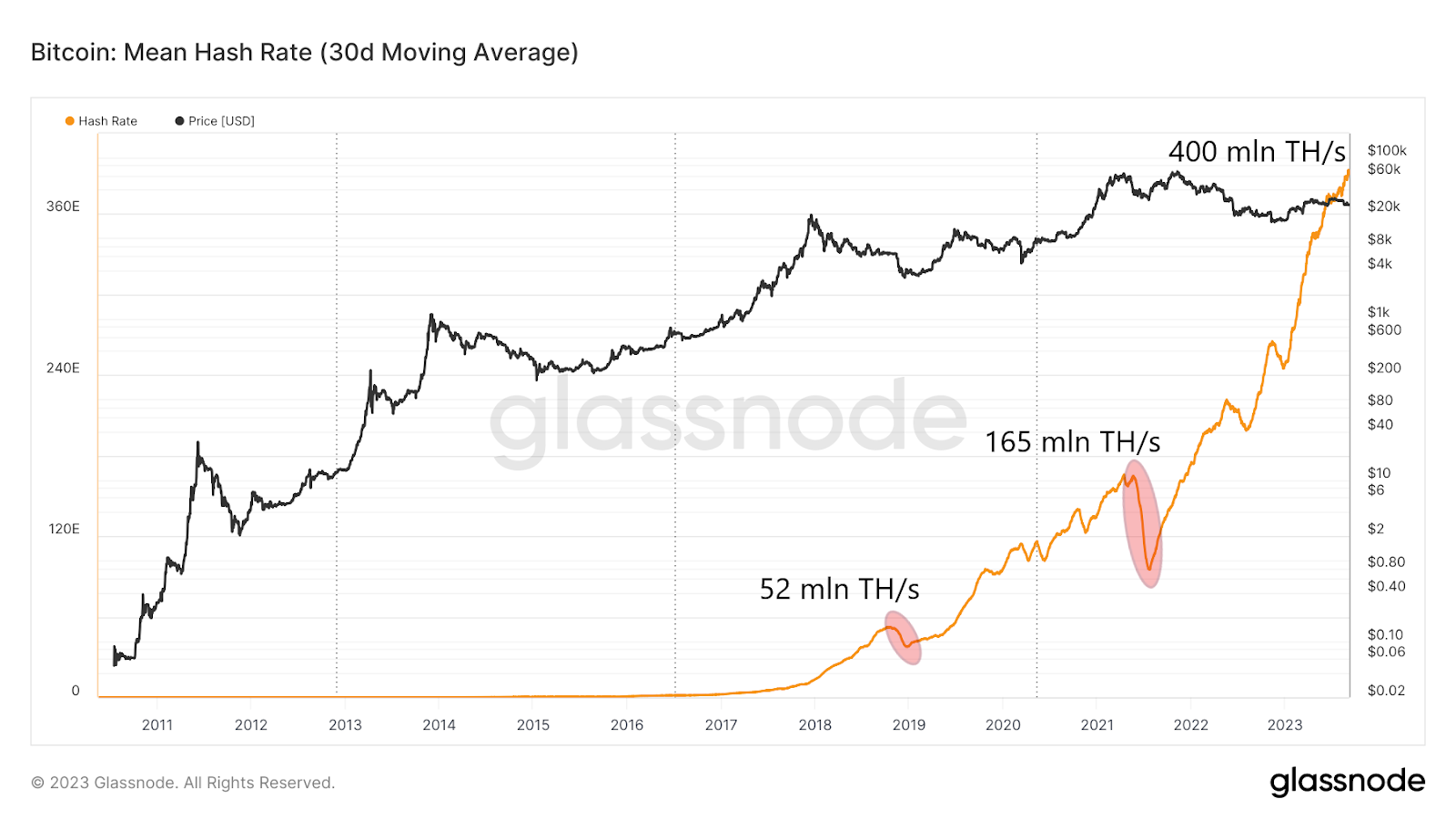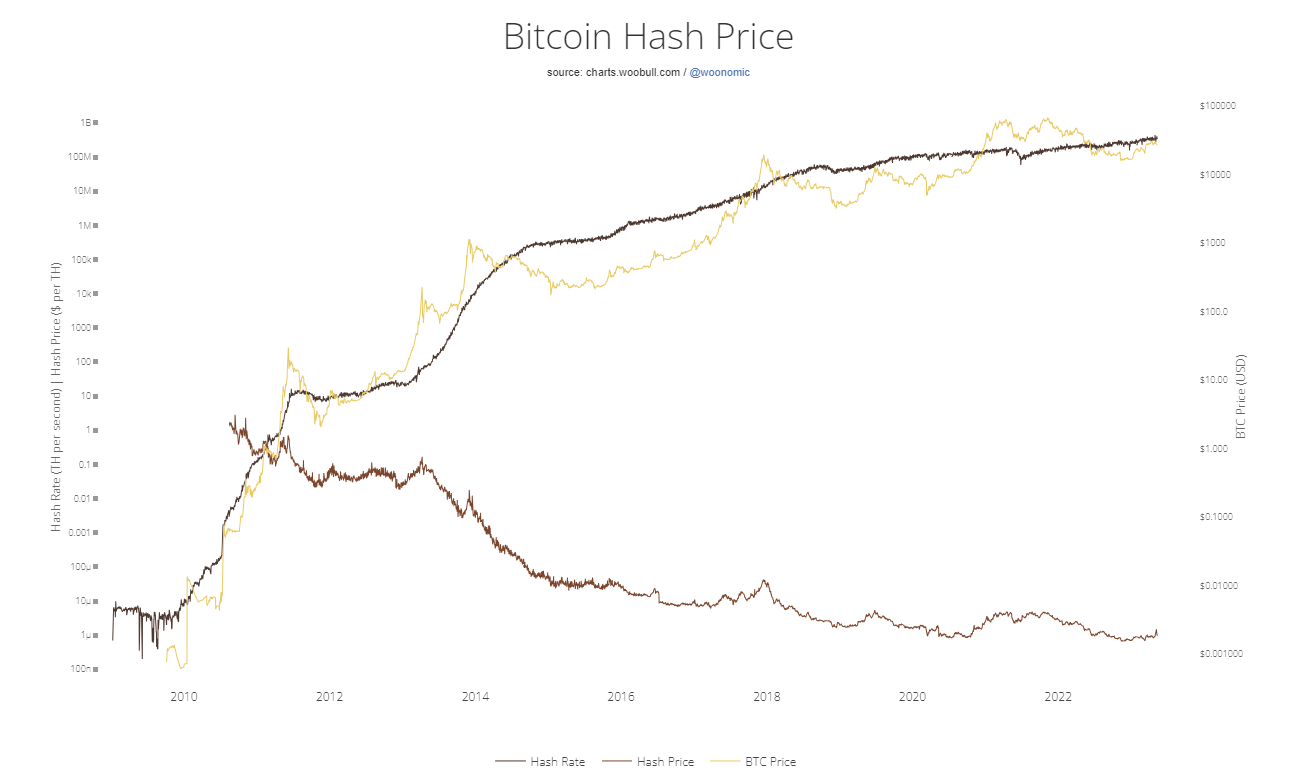As the Bitcoin network becomes more efficient and secure, concerns are being raised about the profitability of BTC miners. Some argue that their declining revenues could, over time, lead to the shutdown of more mining pools, slowing and eventual collapse of the largest blockchain.
On-chain analysis shows that, indeed, both the hash rate of the Bitcoin network and mining difficulty of successive blocks are today at all-time highs. Is there still room for proper earnings for miners in such an energy-intensive and technologically advanced network? Or will declining earnings – as measured by the hash price index – lead to the termination of more mining businesses?
Hash Rate and Mining Difficulty Hit ATH
Hash rate is a basic indicator of the performance and security of the Bitcoin network. It is calculated based on the average estimated number of hashes per second produced by the network’s miners.
On the long-term chart of the hash rate (30-day moving average), we can see its exponential growth since the inception of the oldest blockchain. Currently, the indicator is constantly recording consecutive all-time highs (ATH) and is in the vicinity of 400 million TH/s.
In addition, periodic corrections can be seen, such as at the end of the bear market in 2018 or during the famous China ban in the summer of 2021 (red areas). In the latter case, the hash rate fell by almost 50% from 165 TH/s to 96 TH/s.

For those who understand how the Bitcoin network works, it is obvious that as the computing power measured by the hash rate increases, so does the difficulty of mining BTC. The graph of this indicator is almost identical to the hash rate and today also records its ATH.
Decode tomorrow’s crypto prices today.
If, on the other hand, computing power decreases – for example, by BTC miners disconnecting from the network – the mining difficulty also decreases. It is worth mentioning that the latter adjusts after about 2 weeks (or exactly after 2,016 blocks).

Hash Price Reaches All-Time Low
However, the increasing difficulty of mining and the hash rate of the Bitcoin network are challenging BTC miners. This is because it turns out that more and more resources, energy, equipment and computing power must be involved to compete for block mining rewards.
What’s more, these rewards are halved on average every four years as a result of programmed halving. Currently, the reward for block mining is 6.25 BTC. However, another halving will take place around April 2024, which will reduce it to 3.125 BTC.
So BTC miners are facing two unfavorable trends. On the one hand, it is becoming increasingly difficult to compete with numerous rivals, huge computing power and mining blocks. On the other hand, even successful block mining no longer guarantees such high rewards as in the past.
In general, this leads to a steady decline in miners’ income. One of the most well-known on-chain analysts @woonomic expresses this trend with the hash price indicator. This is the revenue generated by miners on a per terahash basis.
The long-term graph of this indicator is in a long-term downward trend. In a sense, it is the inverse of the hash rate chart, but remains more prone to fluctuations of the BTC price. This is obvious because as the price of BTC increases, miners’ revenues also increase.

Currently, the hash price chart is near the all-time low (ATL). This has raised some concerns about the viability of mining operations and, consequently, the security of the entire Bitcoin network.
Will Bitcoin Mining Become Unprofitable?
Another well-known on-chain analyst @DylanLeClair_ recently spoke on the issue. In a short video, he outlined a hypothetical, bleak future for the Bitcoin network, in which miners do not receive enough reward for their work. They are shutting down their businesses as maintaining the massive amount of equipment and electricity bills become too much to stay profitable.
This leads to the termination of their businesses and an exodus of equipment from the network. The hash rate drops. This then triggers longer transaction times, a spike in transaction fees that can’t be validated on an ongoing basis due to the loss of miners. Blockchain is slowing down.
However, here the analyst points out that this is what the Bitcoin system’s idea of self-regulation is for. Well, after just 2 weeks or so, the mining difficulty adjusts to the new environment and reduced computing power. The business of any miner who has maintained his equipment and is still participating in the network suddenly becomes more profitable. Revenues and hash price increase.
Therefore, Dylan LeClair concludes, no bailouts are needed for miners whose businesses are in danger of collapse. There is no need for government care for these companies, no need to compensate them. The Bitcoin network adjusts itself by virtue of a cryptographic algorithm.
In comments to these explanations, Glassnode’s lead analyst, @_Checkmatey_ tweeted a meme that illustrates “Bitcoin security budget concerns.”
 beincrypto.com
beincrypto.com